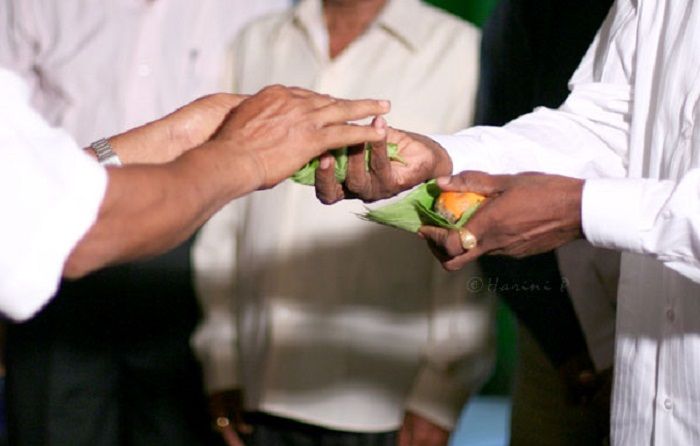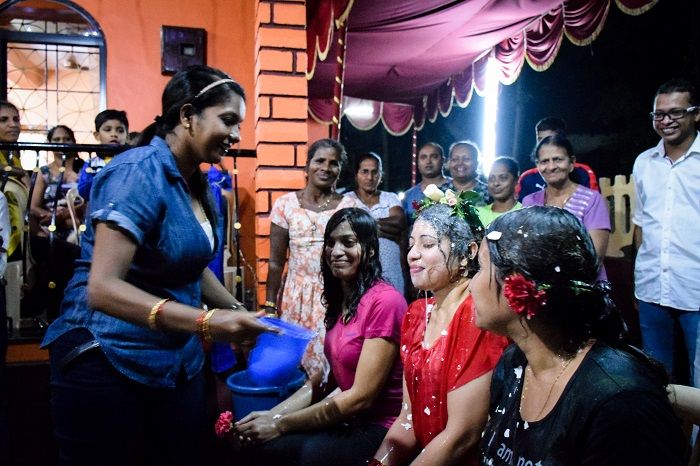
Image Source: Wikimedia.org
Our idea of a typical Christian wedding revolves around frothy white dresses, tons of flowers, and cute flower girls. Subtle and elegant, Christian weddings are a vision in monochrome, but the scenario is a little different as far as Christian weddings in India. Although the basic essence of the rituals is the same as that of a traditional Christian wedding, a host of ethnic Indian rituals have impacted almost all communities throughout the country. They are a fascinating blend of the minimal Hollywood style Christian wedding we see in the movies with adherence to pre and post wedding rituals that are essentially very Indian. Right from the wedding attires to the bridal jewelry, Indian Christian weddings are quite distinct from what we imagine.
Matchmaking
Matchmaking is prevalent in the Indian Christian communities and just like any other community in the country, arranged marriages are quite pervasive. Major Christian population in India is concentrated in South India, North-East India and parts of Konkani coastal areas. Matches are generally arranged within the specific denominations of Christianity that either the bride or the groom belongs to. For example Roman Catholics will prefer a match with a Roman Catholic family and not a Protestant, Presbyterian or Lutheran Christian. Once a preferred match is settled, the families meet and if everyone is satisfied, then the talks proceed. Very often than not, there is a courtship period, where the bride and the groom get to know each other. If they find each other compatible, then formal proposal happens, mostly from the groom’s side. In some cultures in south India, this moment is sealed with discussion of dowry and presenting each other with Betel leaves and betel nut. The ceremony is known as ‘badalchen’.

Pre-wedding Rituals
Engagement – The engagement is perhaps the most important pre-wedding event in a Christian wedding. After formal proposal comes from the groom’s side, a date is set for the formal engagement ceremony. It may be a somber and small affair with just close friends and relatives participating, or it may be a gala bash where acquaintances are invited for a fun-filled exciting evening. Traditionally, the groom is to present a ring to the bride and he places it on her left ring finger. This ritual symbolizes the betrothal of the girl to the groom. The rings have to be blessed by the priest either at the church or at the engagement venue. Nowadays sometimes, the bride also offers a ring to the groom which he wears on his right hand ring finger. The groom also gifts his bride-to-be with other gifts such as clothes, perfumes, handkerchiefs etc. The two families mingle with each other at a party following the ritual. The engagement is generally followed by a courtship period before the actual wedding date is fixed. The engagement is also announced at local churches and sometimes in the local newspapers also.
Bridal Shower – Following the engagement, the bride’s relatives throw her a bridal shower. Mostly young cousins and friends of the bride decide on a day and take the bride out for a merry night. They often host a party where they play a number of games, shower the bride with gifts that she might find useful in her upcoming conjugal life and encourage her to sing and dance to her heart’s content. It is a tradition for the bride to have a pink cake served to her companions where she has hidden a silver thimble. The friend of the girl who is served the piece of cake with the thimble is believed to be the next one getting married. It is the day where the bride gets to do all her favorite things with her girlfriends before she enters into a deeply committed relationship and a life of putting others’ happiness before her own. Nowadays, destination bridal showers are in vogue where the bride’s friends whisk her away from the wedding venue to a beach or on a road trip for her to fully savor her carefree moments.
Bachelor Party – A similar event to the bridal shower is arranged for the groom by his male friends and cousins. Although, it is purely western concept, it is gradually gaining popularity in India. It generally takes place a day before the wedding. The concept is for the groom to enjoy his last day as a bachelor. It may be a party where women are strictly not allowed and men of the family strengthen their male bonding. It is becoming more and more popular to arrange for an away trip for the bachelor in weeks prior to the wedding. Typical favorite include going for some adventure sport like hiking, climbing or trekking. For the typical adrenaline junkies, there is bungee jumping, skydiving, surfing or even diving. In other instances the group might go to a beach house and enjoy a few days of sun and surf away from the wedding buzz. Fishing or a trip to the groom’s favorite vineyard is also some great option to entertain the groom-to-be before he gets hitched.
Roce Ceremony – This is sort of an anointing ceremony that takes place in some of the Indian Christian communities like that from Goa or Konkan. It is similar to the Haldi ceremony of the Hindu weddings and takes place on the eve of the wedding day. It involves the bride and the groom taking a ritualistic bath in their respective homes. The bride/groom is anointed with oil, where the participants, generally relatives, dip their forefingers in the oil and perform the sign of the cross on the forehead of the bride/groom. Oil drops are poured on ears and on the head, followed by coconut juice or roce which is rubbed on the head, face, hands and feet. After this, the bride/groom is bathed with water. The whole ceremony is followed by a roce prayer and then dinner with drinks.

Wedding Attires
For a typical Indian Christian wedding, the groom mostly wears a formal suit. They usually wear a black or white suit depending on the theme of the wedding. He wears a white shirt and has a boutonniere on the left lapel of his jacket.
Contrary to popular concept, the bride does not always wear a white frothy gown. In most Indian Christian communities in the south, sarees are preferred as wedding attires instead of a gown. Goan and Konkani Christians prefer wearing gowns than sarees. These sarees are generally silk ones with heavy gold zari threadwork paired often with a gold brocade blouse. These sarees can be white or gold or beige in color. Kerala Christian brides often wear the simple white Kasavu sarees with broad golden borders paired with white or golden blouse. They may or may not pair it with a veil. The beautifully pleated sarees are paired with gold and often diamond jewelry. If the bride chooses to wear dresses, then they wear dresses made from silk, satin or taffeta with crochet work, paired with a long white veil. The veil is often pinned to the head where the bride mostly sports an up do with a tiara. The bride generally carries a bridal bouquet which may be fully white or may have colorful flowers in them. Similar to the bride, the bridesmaids may wear sarees or dresses in different colors that are mostly not white. Their outfits are generally color coordinated to set off the bridal outfit beautifully.
Wedding Rituals
Welcoming of the Bride – On the morning of the wedding day, female relatives of the groom visit the bride’s home with her bridal outfits, some jewelry, trays of dry fruits, sweets and fruits. The priest is to bless the bridal dress before it is handed over to the bride. The bride gets ready in her house and sets off for the church in a car sent by the groom with some of her friends, generally bridesmaids. Her family follows. She is received at the church by the groom’s family and is escorted into the church by the groom’s best man.
The Wedding Mass – Preceding the actual wedding ceremony, a wedding mass is held in most Indian Christian weddings especially in Roman Catholic orders. During the mass, prayers and hymns are performed by the priest. The program starts with an opening prayer which the guests can join in. Following the opening prayer, the Bible is read both from the New as well as the Old Testament. The verse is chosen by the priest but the reading can be done by a member of the bride or groom’s family. Next part of the program is singing the Psalm, either by the guests or the church soloist. This is followed by the priest rendering the sermons.
The Wedding Vows – After completion of the wedding mass, the priest starts the actual marriage rituals by uttering the Opening remarks where he gives a short speech about virtues of marriage and in some cases about the bride and groom. The bride and groom then are asked to utter the vows of marriage. In India, the vows are mostly decided by the priest and the couple just utters them after him. They essentially promise each other that they will be by each other’s side through all phases of life till death do them part.
Solemnizing of the Marriage – The marriage is solemnized by first exchanging wedding rings. These are mostly simple gold wedding bands that are place on the left hand ring finger of both the bride and groom by each other. Among South Indians, there is an additional custom where the groom ties a Thali around the bride’s neck. Thali is essentially akin to the Mangalsutra, having a leaf-shaped pendant with the symbol of the cross embedded on it, which is strung on a gold chain. The Matrakodi or the Wedding Saree is handed over by the groom to the bride, which she has to wear over her head. Next the bride and groom are blessed by the priest and declared Husband and Wife. They hold hand together and march down from the dais to seek blessings from the elders.
Post-wedding Rituals
Reception - After completion of the wedding ceremony, the couple exits the church amid excited cheering and showering of confetti by the guests. The newlywed couple, along with all the invitees, moves to a banquet hall to attend the wedding reception. Here, there is usually a wedding feast and the guests propose toast to the couple’s well-being. There may or may not be speeches from the best man and maid of honor, but there is always cutting of the wedding cake by the bride and groom who feed each other the first two pieces before it is distributed among the guests. Sometimes, there is a live band or DJ present to encourage the guests to dance.




